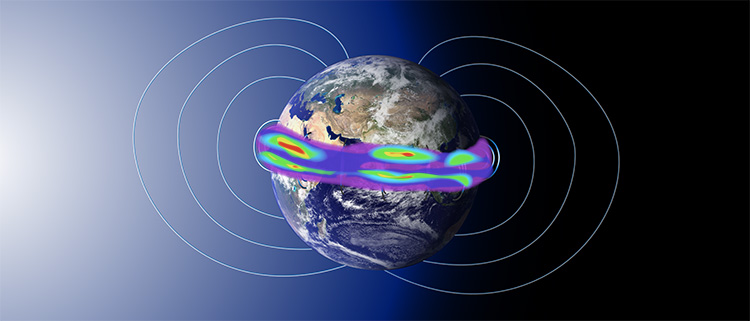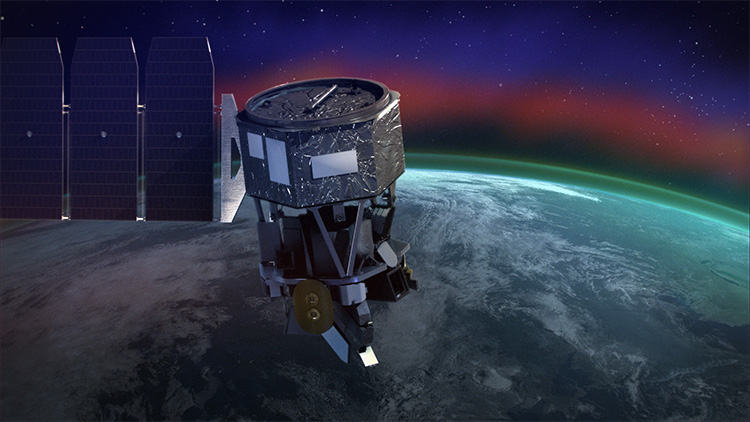June 14 launch of ICON satellite to probe the edge of space
NOTE: A media telecon will be held at 1 p.m. EDT (10 a.m. PDT) Wednesday, June 13, and can be heard live on the agency’s website. To participate by phone, media should contact Karen Fox, Karen.Fox@nasa.gov. by 12:30 p.m. EDT on June 13. Media and the public may ask questions during the event using #askNASA.
Berkeley – If scientists hope to predict the magnetic storms around Earth that endanger satellites and interfere with radio communications on the ground, they must understand how tropical storms on Earth affect these magnetic storms 60 miles above our heads.
A new mission, NASA’s Ionospheric Connection Explorer (ICON) is charged with that very task: to measure the winds of ionized atoms at the edge of space and determine how they are impacted by atmospheric weather, in particular seasonal monsoons in the tropics.
Designed and led by scientists at the Space Sciences Laboratory of UC Berkeley, ICON is scheduled for a June 14 launch from an airplane over the Pacific Ocean, and should start probing the upper atmosphere and ionosphere by August.
“We are built to catch everything that is coming up into space at the boundary of space,” said Thomas Immel, principal investigator for the mission and a physicist at the Space Sciences Laboratory. “Anything that comes past there we are going to see.”
The Space Sciences Laboratory is also hosting a launch event celebration in Berkeley with live NASA TV coverage on June 14 (June 15 local time at launch site overKwajalein). Media are invited to attend, where they can view a full-scale mock-up of ICON. Doors will open at 6:15 a.m. and the event will end by about 9 a.m. Contact Karin Hauck for details.
Looking downward at the edge of space
ICON, which will be launched aboard a Pegasus XL rocket dropped from an L-1011 “Stargazer” aircraft over the Pacific Ocean, will orbit at about 350 miles above Earth’s surface, but will look downward at the region above 60 miles, where the thin upper atmosphere transitions to space and, at 200 Kelvin (100 degrees below zero Fahrenheit), the coldest environment on Earth. The sun is constantly shining on this region, heating it up and, because of the sun’s ultraviolet radiation, knocking electrons off oxygen atoms to produce an ionized gas, or plasma.

This plasma interacts with Earth’s magnetic field, migrating along field lines and generating electric fields that, in turn, shove the ionized plasma perpendicular to the magnetic fields.
The net result of all this moving, ionized gas is to produce waves of plasma that encircle the globe, visible because of airglow in green, red and ultraviolet. The goal of ICON’s two MIGHTI telescopes – short for Michelson Interferometer for Global High-resolution Thermospheric Imaging – is to measure the speed of these plasma waves between 60 to 200 miles above the ground by means of their Doppler shift.
“It’s like watching runners and measuring how fast they are running by the change in the color of their shirts,” Immel said. Designed and built by the Naval Research Lab in Washington, D.C., MIGHTI is sensitive enough to measure the change in color or wavelength to within one part in 100 million, equal to a speed of about 10 miles per hour, and also to take the plasma’s temperature.
Two other instruments built at SSL measure far ultraviolet (FUV) and extreme ultraviolet (EUV) wavelengths to clock the winds at higher elevations in the ionosphere, revealing how far the plasma extends and where pockets of denser plasma form.
“Shortwave radio waves bounce off the ionosphere, and signals from GPS satellites have to pass through,” said Immel. “The changes in density directly affect communications and navigation.”

While ICON’s three airglow instruments measure the temperature, velocity and composition of gases miles away from the spacecraft, two identical instruments – Ion Velocity Meters, or IVMs, developed at the University of Texas in Dallas – measure the movement of the charged gas around the spacecraft.
One puzzle Immel hopes to investigate involves two belts of plasma girdling Earth just north and south of the equator. For unknown reasons, these belts sometimes rise upward and migrate toward each pole and at other times stall and merge into one belt.
Tropical rains around the world, in South America, Africa and Southeast Asia, seem to change these plasma belts with a daily regularity that matches the early afternoon downpours typical of monsoons. One goal of ICON is to find out what connection, if any, exists between tropical storms and tides in the plasma waves in the ionosphere.
ICON will also be able to measure how the ionospheric plasma waves change when hit by magnetic storms from the sun.
Eventually, what ICON discovers will be combined with observations from other Earth-orbiting satellites to make predictions about space weather tomorrow based on observations today.
“At some point we will hand off to an agency in charge of space weather and the space environment, and we have to give them a hint of what to measure to make predictions,” Immel said. “ICON will inform the next set of measurements and identify key parameters that need to be measured to support better predictions in the future.”
ICON is a $180 million Explorer-class mission managed by NASA Goddard Spaceflight Center in Maryland.
RELATED INFORMATION
